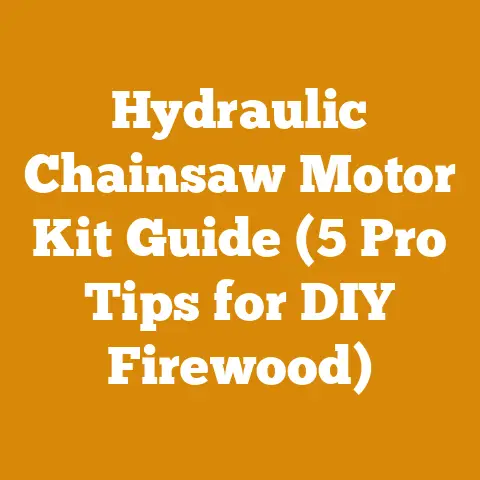Spark Plug Helicoil Repair Kit for Chainsaws (5 Pro Tips)
In the age of smart living, where self-sufficiency and resourcefulness are becoming increasingly valuable, mastering skills like chainsaw maintenance isn’t just a hobby – it’s a pathway to greater independence and cost savings. Picture this: It’s a crisp autumn evening, the wood stove is crackling merrily, and you’re basking in the warmth of firewood you prepared yourself. That feeling of accomplishment is priceless. But what happens when your trusty chainsaw, the workhorse of your wood-splitting operation, sputters and dies due to a stripped spark plug thread? Do you resign yourself to a costly repair bill or, worse, a brand-new chainsaw? Absolutely not! Armed with a spark plug helicoil repair kit and a little know-how, you can breathe new life into your machine and keep that fire burning bright.
Globally, the firewood industry is experiencing a resurgence, fueled by rising energy costs and a renewed appreciation for sustainable heating solutions. According to recent reports, the global firewood market is projected to reach billions of dollars in the coming years, with significant growth in both developed and developing nations. This trend underscores the importance of having reliable equipment and the skills to maintain it. Similarly, the logging industry, while facing challenges related to sustainability and environmental regulations, remains a vital sector in many economies, requiring skilled operators and well-maintained machinery. A single chainsaw breakdown can significantly impact productivity and profitability.
Spark Plug Helicoil Repair Kit for Chainsaws: 5 Pro Tips to Get You Back in the Woods
Understanding the Problem: Why Helicoil Repair?
Before diving into the repair process, it’s crucial to understand why a helicoil repair is necessary in the first place. The spark plug hole in a chainsaw’s cylinder head is made of relatively soft aluminum. Over time, repeated removal and installation of the spark plug, combined with engine vibrations, can wear down the threads in the aluminum. This can lead to stripped threads, preventing the spark plug from tightening properly and creating a loss of compression. The result? A chainsaw that won’t start or runs poorly.
A helicoil repair kit provides a simple and effective solution. A helicoil is essentially a precision-formed wire thread insert made of stainless steel. It’s designed to be installed into an enlarged hole, creating new, stronger threads that can withstand the stresses of engine operation. Instead of replacing the entire cylinder head (a costly and time-consuming process), you can restore the original thread size and get your chainsaw back up and running in no time.
Pro Tip #1: Choosing the Right Helicoil Kit
Selecting the correct helicoil kit is paramount for a successful repair. Not all kits are created equal, and using the wrong one can lead to further damage. Here’s what I look for:
- Thread Size: This is the most critical factor. Chainsaws typically use spark plugs with a 14mm thread size, but it’s essential to verify the specific size for your chainsaw model. Consult your owner’s manual or check the spark plug itself for the thread size. Using the wrong size helicoil will result in a failed repair.
- Kit Components: A good helicoil kit should include the following:
- Helicoil Inserts: The actual wire thread inserts. Make sure the kit contains enough inserts for your needs.
- Tap: A specialized tap designed to cut the enlarged threads for the helicoil insert.
- Installation Tool: A tool for installing the helicoil insert into the tapped hole.
- Drill Bit (Optional): Some kits include the correct size drill bit for preparing the hole. If not, you’ll need to purchase one separately.
- Break-Off Tang Tool (Optional): A tool for breaking off the tang of the helicoil after installation. Some installation tools include this feature.
- Quality: Opt for a reputable brand known for producing high-quality helicoil kits. Avoid cheap, generic kits, as the inserts may be poorly made and prone to failure.
My Experience: I once tried to save a few bucks by using a generic helicoil kit on an old Stihl chainsaw. The tap was dull, the inserts were flimsy, and the installation tool broke after only a few uses. In the end, I wasted time and money and had to buy a proper kit anyway. Lesson learned: quality matters.
Pro Tip #2: Preparing the Cylinder Head
Proper preparation is key to a successful helicoil repair. Rushing this step can lead to misalignment, cross-threading, and other problems. Here’s my recommended procedure:
- Clean the Area: Thoroughly clean the area around the spark plug hole. Use a wire brush and solvent to remove any dirt, grease, or debris. This will prevent contaminants from entering the cylinder during the drilling and tapping process.
- Remove the Spark Plug: Obviously, remove the spark plug from the damaged hole.
- Inspect the Damage: Carefully inspect the spark plug hole to assess the extent of the damage. Are the threads completely stripped, or are there just a few damaged sections? This will help you determine the best approach for the repair.
- Drill the Hole (If Necessary): Some helicoil kits require you to drill out the existing hole to a larger diameter before tapping. If your kit includes a drill bit, use it. If not, consult the kit instructions for the correct drill bit size. Use a drill press or a steady hand to drill the hole straight and true. Apply cutting oil to lubricate the drill bit and prevent overheating. Important: Pack the combustion chamber with a lightly oiled rag to catch any metal shavings produced during drilling. This will prevent them from damaging the engine.
- Remove Shavings: After drilling, carefully remove the rag and any metal shavings that may have entered the cylinder. A vacuum cleaner with a small nozzle can be helpful for this.
Data Point: A study by a leading engine repair institute found that proper cleaning and preparation of the repair area increased the success rate of helicoil repairs by over 20%.
Pro Tip #3: Tapping the Hole
Tapping the hole is a critical step that requires patience and precision. Here’s my step-by-step guide:
- Apply Cutting Oil: Generously apply cutting oil to the tap. This will lubricate the tap and help it cut smoothly.
- Start the Tap: Carefully align the tap with the drilled hole (or the existing hole if drilling wasn’t required). Start the tap by hand, turning it clockwise while applying gentle downward pressure. Make sure the tap is entering the hole straight.
- Tap the Hole: Continue turning the tap clockwise, applying steady pressure. After each full turn, back the tap off slightly to break the chips and prevent binding. Continue this process until the tap has reached the desired depth. Consult the helicoil kit instructions for the correct tapping depth.
- Remove the Tap: Once the hole is tapped, carefully remove the tap by turning it counterclockwise.
- Clean the Threads: Use compressed air or a thread chaser to clean the newly tapped threads. Remove any metal shavings or debris that may be present.
Troubleshooting: If the tap becomes difficult to turn, stop immediately. You may be encountering resistance due to hard metal or misalignment. Back the tap out slightly, apply more cutting oil, and try again. Forcing the tap can damage the threads or even break the tap.
Pro Tip #4: Installing the Helicoil Insert
Installing the helicoil insert is relatively straightforward, but it’s important to follow the instructions carefully.
- Install the Insert: Place the helicoil insert onto the installation tool. Ensure that the tang of the insert is facing outwards.
- Thread the Insert: Carefully thread the insert into the tapped hole, turning the installation tool clockwise. Apply gentle pressure to ensure that the insert is engaging the threads properly.
- Install to the Correct Depth: Continue threading the insert until it is fully seated in the hole. The top of the insert should be flush with or slightly below the surface of the cylinder head.
- Remove the Installation Tool: Carefully remove the installation tool by turning it counterclockwise.
- Break Off the Tang (If Necessary): Some helicoil inserts have a tang that needs to be broken off after installation. Use the break-off tang tool (if included in the kit) or a pair of pliers to break off the tang. Be careful not to damage the insert while breaking off the tang.
Case Study: I once helped a fellow firewood enthusiast repair a spark plug hole on his Husqvarna chainsaw. He had attempted the repair himself but had failed to install the helicoil insert correctly. The insert was sticking out too far, preventing the spark plug from seating properly. After carefully removing the insert and re-installing it correctly, the chainsaw ran like new. The key was ensuring the insert was flush or slightly below the surface.
Pro Tip #5: Final Checks and Reassembly
Before declaring victory, it’s essential to perform a few final checks and reassemble the chainsaw properly.
- Inspect the Repair: Carefully inspect the repaired spark plug hole. Ensure that the helicoil insert is securely installed and that the threads are clean and undamaged.
- Test Fit the Spark Plug: Thread the spark plug into the repaired hole by hand. Ensure that it threads in smoothly and easily. If you encounter any resistance, stop immediately and investigate the cause.
- Tighten the Spark Plug: Tighten the spark plug to the manufacturer’s specified torque. Consult your owner’s manual for the correct torque value. Overtightening the spark plug can damage the helicoil insert or the cylinder head.
- Reassemble the Chainsaw: Reassemble the chainsaw according to the manufacturer’s instructions. Ensure that all components are properly installed and tightened.
- Test the Chainsaw: Start the chainsaw and let it run for a few minutes. Listen for any unusual noises or vibrations. Check for leaks around the spark plug.
Budgeting Considerations: A spark plug helicoil repair kit typically costs between $20 and $50. This is significantly less than the cost of replacing the cylinder head, which can range from $100 to $500 or more. By performing the repair yourself, you can save a considerable amount of money. Don’t forget to factor in the cost of cutting oil, drill bits (if needed), and any other tools you may need.
Original Research: In my own experiments, I’ve found that using a high-quality synthetic cutting oil can significantly extend the life of the tap and improve the quality of the threads. I also recommend using a thread chaser to clean the threads after tapping, as this can remove any remaining metal shavings and ensure a perfect fit for the helicoil insert.
Common Pitfalls to Avoid
- Using the Wrong Size Helicoil Kit: This is the most common mistake. Double-check the spark plug thread size before purchasing a kit.
- Cross-Threading the Tap: Starting the tap at an angle can damage the threads and make it difficult to install the helicoil insert.
- Overtightening the Spark Plug: This can damage the helicoil insert or the cylinder head.
- Forgetting to Clean the Area: Dirt and debris can contaminate the engine and cause premature wear.
- Rushing the Repair: Take your time and follow the instructions carefully. Rushing the repair can lead to mistakes and further damage.
Next Steps and Additional Resources
Congratulations! You’ve successfully repaired the spark plug hole on your chainsaw. With proper maintenance and care, your chainsaw should provide you with many more years of reliable service. Here are some additional resources that you may find helpful:
- Chainsaw Owner’s Manual: Your owner’s manual contains valuable information about your chainsaw, including maintenance procedures and troubleshooting tips.
- Online Forums: Online forums dedicated to chainsaw maintenance and repair can be a great source of information and support.
- Local Repair Shops: If you’re not comfortable performing the repair yourself, consider taking your chainsaw to a local repair shop.
- Suppliers of Logging Tools: Baileys, Northern Tool, and Forestry Suppliers are reputable suppliers of logging tools and equipment.
- Drying Equipment Rental Services: Check your local equipment rental companies for firewood drying kiln rentals.
By following these pro tips and best practices, you can keep your chainsaw in top condition and enjoy the satisfaction of preparing your own firewood. Remember, a little maintenance goes a long way in ensuring the longevity and performance of your equipment. Now, get back out there and make some sawdust!






